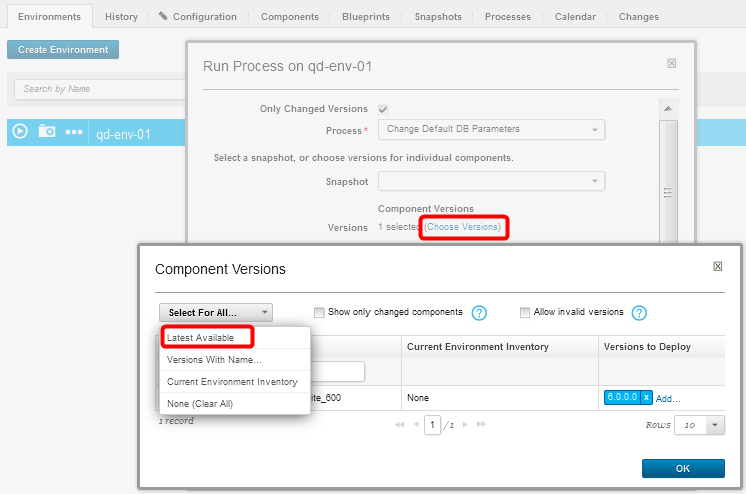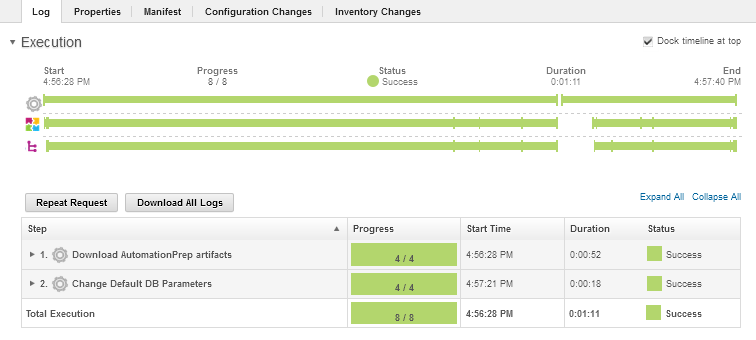IBM Quick Deployer change default SQL Server database parameters 
Authors: ThomasPiccoli, KennethThomson, JenniferLiu, KenTessier, ClareCartyBuild basis: CLM 6.0, CLM 6.0.x, CE 6.0.x
Page contents
The values contained in the default database parameters are used to configure the connections between the installed CLM applications and their individual databases. If you are going to use the Quick Deployer-installed SQL Server database then there is no need to change them prior to running the UCD application Install Applications process. However, you should have your database administrator review the configuration to make sure it conforms to internal security and reliability policies.
If you are going to use an existing SQL Server database instance then you need to ensure that the default database parameters are updated to match the configuration used by your database instance. To do this follow the instructions in this topic.
If you are going to use an existing SQL Server database instance then you need to ensure that the default database parameters are updated to match the configuration used by your database instance. To do this follow the instructions in this topic.
Change default database parameters
- Open application Rational_QD_60x, click Environments, then click the Request Process icon for the target environment.

- In the Process field, select Change Default SQLServer Parameters.

- If you fixed the component versions on the process you will not be prompted to choose versions. If offered to choose the component versions, then select Latest Available.

- Modify the process property default values to match your database.
The SQL Server databases are created using this command db2 CREATE DATABASE ${app}DBName $create{app}DBOption which is populated using these property values:
eg db2 CREATE DATABASE $jtsDBName $createjtsDBOption
The properties are as follows- sqlserverInstanceName :
Default: "CLMINST" - sqlserverCollation :
Default : SQL_Latin1_General_CP437_CS_AS - jtsDBName : name of the jts database
Default: "jts" - jtsDBuser : jts user name
Default : jtsDBuser - ccmDBName : name of the ccm database
Default: "ccm" - ccmDBuser : ccm user name
Default : ccmDBuser - qmDBName : name of the qm database
Default: "qm" - qmDBuser : qm user name
Default : qmDBuser - rmDBName : name of the rm database
Default : rm - rmDBuser : rm user name
Default: "rmDBuser" - dccDBName : name of the dcc database
Default : dcc - dccDBuser : dcc user name
Default: "dccDBuser" - lqeDBName : name of the lqe database
Default : lqe - lqeDBuser : lqe user name
Default: "lqeDBuser" - ldxDBName : name of the ldx database
Default : ldx - ldxDBuser : ldx user name
Default: "ldxDBuser" - lqeDBName : name of the lqe database
Default : lqeDB - relmDBName : name of the relm database
Default on: "relm" - relmDBuser : relm user name
Default : relmDBuser - dmDBName : name of the dm database
Default on: "dm" - dmDBuser : dm user name
Default : dmDBuser - gcDBName : name of the gc database
Default : gc - gcDBuser : gc user name
Default : gcDBuser - dwDBName : name of the datawarehouse database
Default : dw - dwDBuser : datawarehouse user name
Default : dwDBuser - sqlserverPort : database connection port
Default : 1433 - amDBName : name of the am database
Default : am - amDBuser : am user name
Default : amDBuser
- sqlserverInstanceName :
- Click on Submit and wait for the process to run to completion

Miscellaneous
Notes:
- Throughout the IBM Quick Deployer wiki the screen captures are for reference only.
In some cases if the functionality they display has not changed in the latest release they will be from a previous release
Related topics:
External links:
Additional contributors: MichelleCrane, NathanBak, ChristianLopez
Contributions are governed by our Terms of Use. Please read the following disclaimer.
Dashboards and work items are no longer publicly available, so some links may be invalid. We now provide similar information through other means. Learn more here.